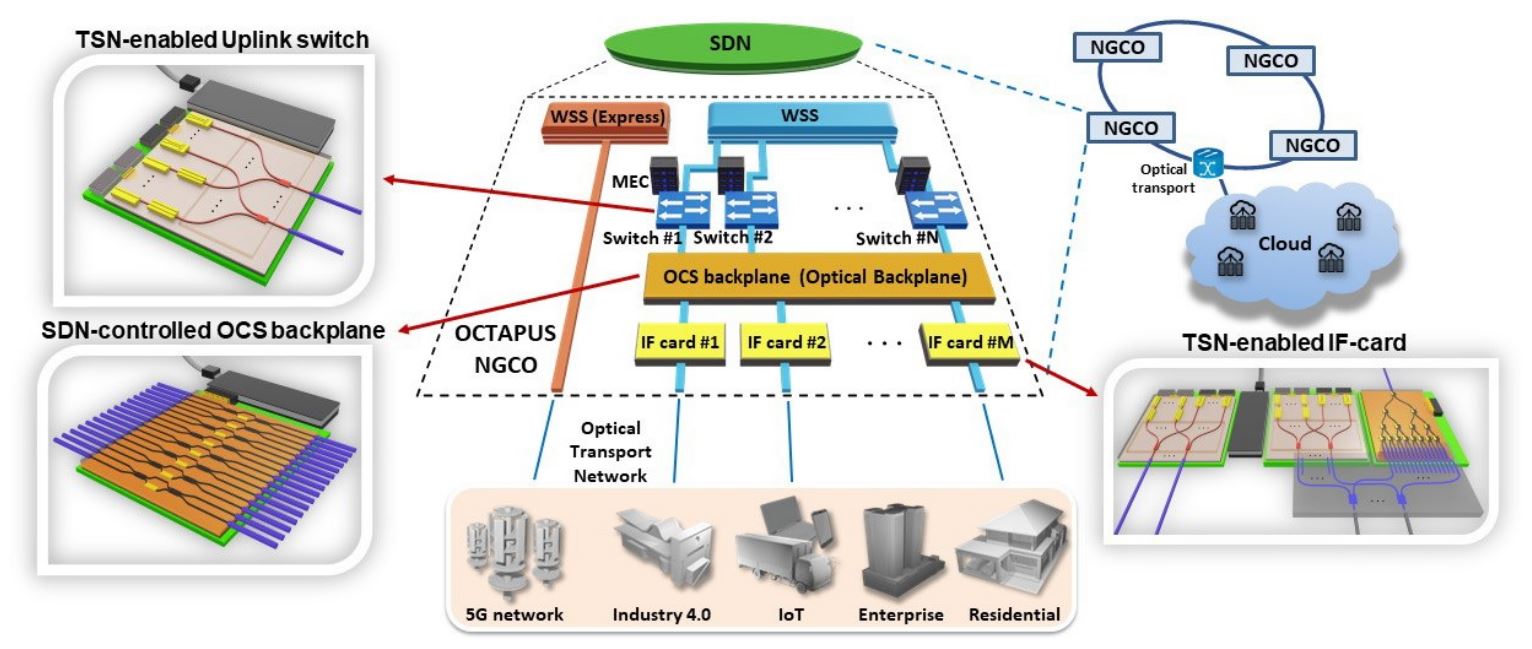Photonic Kit for Network Architecture at Speeds above 50 Terabits per Second
A newly launched European research project intends to establish an agile, economical, and energy efficient technology framework for photonic integrated circuits (PIC) that have the potential to revolutionize the Next Generation Central Office (NGCO) ecosystem with capacities of 51.2 terabits per second and more. The proposed gamechanger: a reconfigurable optically activated backplane and novel toolkit for photonic transceivers.
The OCTAPUS project (acronym for "Optical circuit switched time sensitive network architecture for high-speed passive optical networks and next generation ultra-dynamic & reconfigurable central office environments") proposes a concrete design concept to cover the following five goals:
- Novel non-volatile antimony (Sb) phase change materials (PCM) will be used in the development of a set of unpowered and extremely lossless electro-refractive switches on SiN basis that allow reconfiguration at nanosecond timescales and reduce loss by two orders of magnitude when compared to conventional GST PCMs.
- An energy and cost-efficient 50GHz O-band will be developed with On-Off Keying (OOK) components and I/O portfolio to reduce power consumption by a factor of 4 to 8 over the current state of the art for optical transceiver engines in board-to-board and long-range passive optical network (PON) communication at speeds up to 800 Gb/s, while reducing costs by up to 37.5%.
- A pool of advanced optical components will demonstrate the energy efficiency and ultrafast reconfiguration of optical backplane technology for NGCOs.
- Optically activated backplane technology will be used to construct a low-energy, high-power, scalable NGCO ecosystem that can be reconfigured by software defined networking (SDN) and offers deterministic service standards for time-sensitive communication by supporting a range of time-sensitive networking (TSN) protocols, while also ensuring reliable communication with extremely low latency in telecommunications and industry applications.
- A scalable NGCO architecture will be demonstrated with capacities of up to 200 TB/s and a series of lab and field trials will be conducted with the advanced optical components in time-sensitive applications.
OCTAPUS (Grant Agreement 101070009) is a project pursuing ambitious, but specifically and clearly defined technology goals with industry enterprises in the lead. Its main thrust is to fulfil the promise of high-speed, low-latency, and low-power communication with the immense capacities afforded by the NGCO infrastructure. The consortium was assembled with the strategic purpose to span the entire technology development chain and bring together a high-quality combination of top industry and research partners that can cover all of the technology requirements and application perspectives.
The OCTAPUS team is drawn from two premier European research institutions (Fraunhofer IZM and IMEC), two network operators (ORANGE, COSMOTE), one ICT equipment manufacturer (NVIDIA), two leading universities (Aristoteles University of Thessaloniki AUTH and the University of Southampton as associate partner), and four established SMEs (NEXTWORKS, SMART Photonics, TEEM Photonics, and COMCORES). With this complement of expertise, the project has real momentum for translating the project’s objectives into meaningfully marketable knowhow.
The OCTAPUS project budget is supported with 4.8 million EUR as part of the HORIZON-CL4-2021-DIGITAL- EMERGING-01 call and is scheduled to run from 1 September 2022 to 28 February 2026.
Last modified:
 Fraunhofer Institute for Reliability and Microintegration IZM
Fraunhofer Institute for Reliability and Microintegration IZM
